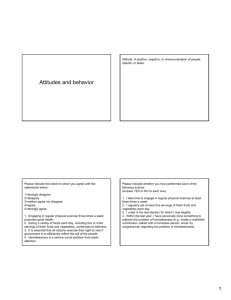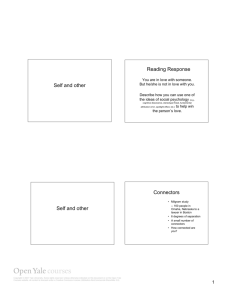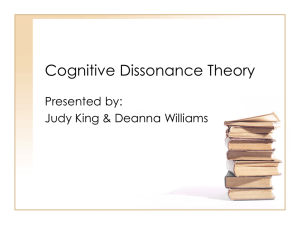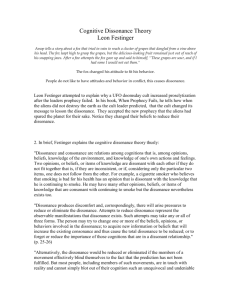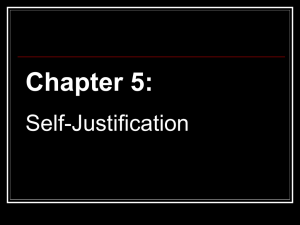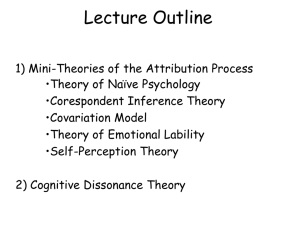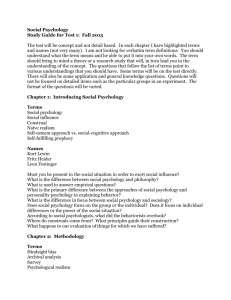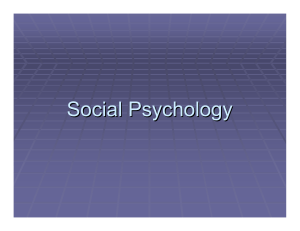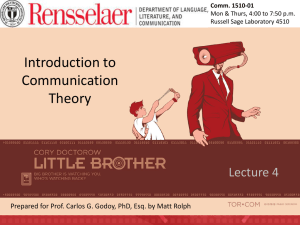class 22 cognitive dissonance
advertisement
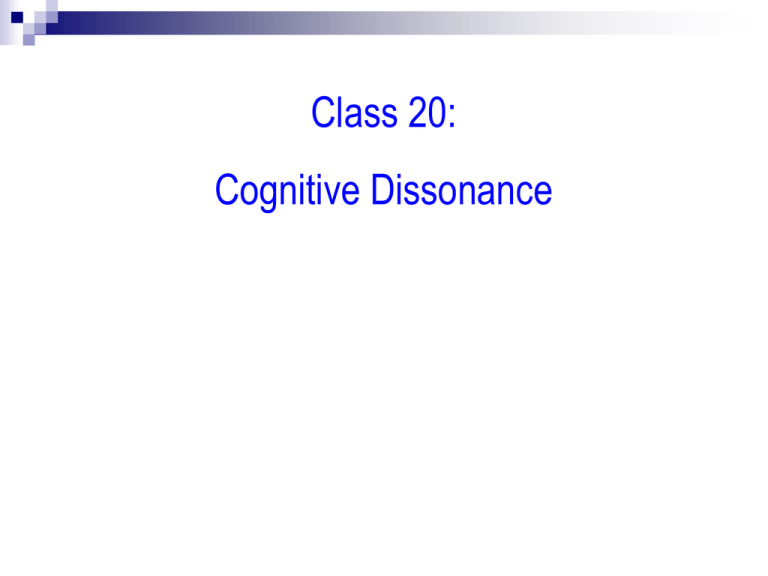
Class 20: Cognitive Dissonance Social Exclusion and the Need to Belong Williams, Cheung, & Choi, (2008) JPSP Need to belong is powerful. Groups punish members by excluding them. Ostracism understood as potent social tactic, even in childhood. Function: Keeps groups cohesive, but devastating to targets. Reactions to ostracism: depression, loneliness, anxiety, frustration, invisibility, helplessness. Frustrates four basic needs: Belonging, self-esteem, control, meaning. Cyberball: Williams, K. D., & Jarvis, B. (in press). Behavior Research Methods, Instruments, and Computers. Effects of Ostracism on Basic Needs Williams, Cheung, & Choi, (2008) JPSP, Study 1 NOTE: Higher scores = worse outcome 25 20 Included Partial Ost. Total Ost 15 10 5 0 Belonging Control Meaning Esteem Mood Ostracism and Conformity Williams, Cheung, & Choi, (2008) JPSP, Study 2 Ss ostracized, not ostracized Ss complete Asch-like visual task, designated the "last" responder 60 50 40 Included Excluded 30 20 10 0 Belonging Need Trials Conformed Percent Ss conformed 1 or more times Social Exclusion, Need to Belong, and Behavioral Mimicry Lakin, Chartrand, & Arkin, Psych Science (2008) Behavioral Mimicry: People automatically, unconsciously mimic behaviors of those with whom they interact. Ss included or excluded by member of in-group (same gender) or out-group (diff. gender) Excluded by: In-group In-group Out-group "mover" "mover" 1 4 Out-group 2 5 Not Excluded 3 6 Proportion Time Mimicking Ss interact with confed (same/diff gender) whose foot moves. Results? 0.4 0.35 0.3 0.25 In-Group Mimicry Confed Out-Group Mimicry Confed 0.2 0.15 0.1 0.05 0 Excluded by InGroup Excluded by Outgroup No Exclusion A Case Study in Mirroring Marx, Marx, & Marx, 1933 http://www.youtube.com/watch?v=j5lU52aWTJo Cognitive Dissonance CD Defined: Cognitive Dissonance is a negative drive state that occurs when a person holds two inconsistent thoughts. To reduce dissonance, person must: a. Change behavior b. Change cognitions Humans are not a rational animal, but a rationalizing one. Leon Festinger Cognitive Dissonance Key Contributors Kurt Lewin Leon Festinger Eliot Aronson Daryl Bem (bete noire) When Prophesy Fails (Festinger, 1954): A (Late Night) Field Observation of CD Festinger and associates read news article about doomsday cult: Marian Keech (L.R. Hubbard associate) receives "automatic writing" message from Planet Clarion--world to end in great flood on 12/21/1954. Keech and followers prepare for rescuing flying saucer by leaving spouses, jobs, college, and giving away money and possessions. Festinger et al. infiltrate cult to observe. When Prophesy Fails (Festinger, 1954): Sequence of Events Group develops belief system from automatic writing Messages state world ends in great flood on 12/20/1954 at 7:00 AM, except for Keech and followers, to be rescued at midnight. Dec. 20 -- Rescue Day: At midnight Visitors to rescue cult; all metallic items removed (watches, bras, belts, zippers) 12:05 -- No Visitors!!! Clock may be running fast; wait 5 more min. 12:10 -- No Visitors!!! Group sits in stunned silence. Cataclysm only 7 hrs away!! 4:00 -- Group sits in stunned silence. Keech begins to cry. 4:45 -- Another message via auto-writing: Destruction called off b/c of faith of little group of believers!!! Afternoon -- Group no longer publicity shy; begins urgent campaign to spread its message. Brehm (1956): Spreading of Alternatives Following Choice Ss rate two appliances of near equal appeal (e.g., toaster, can-opener) At later time, Ss choose between appliances. Ss then re-rate how much they like chosen, dislike rejected. Time 2 ratings compared to Time 1 Ratings. Finding? Selected item liked more, rejected item liked less. Why? Cognizance of selected items deficiencies, rejected items benefits, create dissonance. Dissonance alleviated by enhancing chosen, denigrating rejected. Social, inter-group, interpersonal implications? College Choice, Dissonance, and Theology Colleague explains "Spreading of Alternatives” to her class. Imagine you were accepted by two colleges, of near equal appeal, perhaps for different reasons. College A has better social life, College B has better academics. You can only attend one. Creates a crisis. You pick College A. After you make choice College A seems like a much better school, and College B seems less good. This is dissonance reduction. Student approaches instructor, says had exactly this crisis. Prayed for insight, and after making choice it all made sense. But, you're saying it wasn't The Lord, it was (pointing at PowerPoint slide) THAT!?! Aronson & Mills Initiation Study, 1959 1. Ss go through a difficult or easy initiation in order to qualify to join a sex-issues discussion group. 2. Group turns out to be dull and boring. Which subjects experience the most dissonance? Which group is more likely to rate the dull discussion group as more interesting? Why? Easy Initiation X Hard Initiation Easy Initiation X Hard Initiation Paid high cost for unsatisfying outcome "Underjustification". Festinger & Carlsmith, 1959 "Believing Own Lies" 1. Ss perform very dull task, repeatedly. 2. Ss asked to inform next subject that the task is interesting. 3. Ss offered low pay ($1) or high pay ($20) to lie. 4. Ss later asked to rate how interesting they found the task. Which group experiences most dissonance? X $1 $20 Which group rates the task as more interesting? X $1 $20 Why? $1 = low justification dissonance $20 = high justification no dissonance Dissonance and Behavioral Control: Robbie the Robot Study Lepper, 1972 1. Child rates toys, including desirable "Robbie the Robot". 2. E. leaves room, tells child "don't play w' Robbie, and if you do:" a. Low threat: I will be a little annoyed with you. b. High threat: I will be very angry, and will do something. 3. Child returns to study later, new E., can play with any toy including R. the R. 4. Which child plays w' R the R? Low threat or high threat? Why? Low threat X High threat Low threat = under-justification dissonance Why? Dissonance Disrupts Behaviorism Premise of behaviorism: Punishments are negatively reinforcing. Question: What conditions produce more liking of neutral stims? Neutral Stimuli Reinforcement Beh. Predicts CD Shows Dull discussion group Embarrassment Dislike Liking Fill bin with spools Low pay Dislike Liking Mediocre toys Punishment threat Dislike Liking Self Perception Theory Challenges Cog. Dissonance Cog. Dissonance Theory: Discordance btwn. actions and beliefs creates negative arousal. Hence, dissonance is motivational/affective Daryl Bem: No need to posit any underlying arousal. Could be purely self-perception. People evaluate own actions as they would others. NOTE: Harks back to "Symbolic Interactionism" No internal conflict or complex motives, just attributions based on self-observed behavior. Testing Self-Perception Vs. Dissonance Bem & McConnell, 1970 Premise: We infer own attitudes from our most recent behavior. Beh. due to "insufficient justification", infer corresponding attitude. After new attitude adopted, old attitude will be forgotten. No "change in attitude" Instead earlier attitude "overwritten" by self-perceived new attitude. Method: Counter-Attitudinal Essay, low justification vs. high justification DV: Attitude recall Result: Which group better recalls initial attitude, low or high justification? High justification. Why? Saw selves voicing views under powerful external pressure. Views voiced under pressure probably not sincere. Arousal as a Necessary Condition for Cog. Diss. and Attitude Change Cooper, Zanna, & Taves, 1978 Premise: Damn you Bem, it is arousal!!!! If arousal, then if arousal dampened, less CD; if arousal boosted, more CD "Attitudes will change following counter-attitudinal behavior if and only if arousal accompanies behavior." Method: Ss complete counter-attitudinal essay--"Should Richard Nixon be pardoned?" Either high-choice or low choice conditions. Before essay, as part of "separate study" Ss ingest pill. Told it is placebo but in actuality it is either: tranquilizer, placebo, amphetamine Tranquilizer Predict: Attitude change in "high choice" but not if pill is _____________? Arousal as a Necessary Condition for Cog. Diss. and Attitude Change Cooper, Zanna, & Taves, 1978 Tranq'zer
